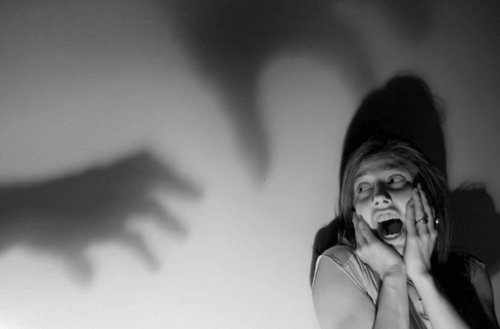Say Goodbye to Your Anxiety With Mindfulness

Human beings have the capacity to experience a different type of fear than animals, psychological fear. Its great particularity is that it has nothing to do with any real, objective or immediate danger. Mindfulness can help you overcome this psychological fear we are referring to: anxiety.
Psychological fear always refers to something that could happen or something that already happened and could happen again. It doesn’t refer to something that is happening in this very moment.
The body of a person suffering from this fear is in the “here and now”. However, their mind is in the future, anticipating possible realities or new repetitions of past realities.

Mindfulness and the ailment of thinking
The ailment of thinking refers to an uncoordinated state between the mind and the body. Thoughts go one way, emotions go another and physical sensations go in a third direction. With mindfulness, we attempt to coordinate these elements in perfect harmony.
Putting it simply, we’re not only living in the present. We are actually experiencing life in a fragmented state. Our perception of reality is divided, dispersed, and distorted. In addition, we have lapses in attention and interpretations. Finally, pathological anxiety makes its entrance.
The mind of an anxious person has a life of its own. It lives separate from the body and from objective reality. The anxious mind is constantly trying to avoid a future danger. This is so, until the body ends up suffering from various types of anxiety disorders.
The ailment of thinking is a state of lack of coordination between the mind and the body. Thoughts, emotions and physical sensations are all in different “frequencies”.
Anxiety as an experiential avoidance in mindfulness
The particular way of behaving used by people who suffer from anxiety is called (in terms of mindfulness) “experiential avoidance”. Experiential avoidance occurs when a personal doesn’t wish to remain in contact with a certain experience (corporal sensations, emotions, thoughts, memories, etc). Therefore, the person alters the frequency and the way these events occur as well as the context which produce them.
Experiential avoidance doesn’t allow us to stay in contact with certain experiences, and makes us alter their very nature. This contributes to anxiety disorders.
Such efforts to avoid these experiences leads directly to the opposite. They exacerbate the events until they make the person feel even more out of control. Thus, people with a pattern of experiential avoidance will have a much higher chance of developing even more fear.
These people will also flee more in an unexpected panic attack than people who accept their inner experiences better. The suppression of thoughts and feelings clearly contributes to generalized anxiety disorder, specific phobias and post-traumatic stress disorder.

The most important characteristics, common to all anxiety disorders, to which mindfulness is directly aimed at are the following:
- Behavioral and experiential avoidance (already explained above)
- Cognitive rigidity (or in other words, the tendency of consciously always thinking in the same way or not contemplating alternatives)
- A rigid repertoire of responses (always doing the same thing, remaining stuck)
How can mindfulness help us reduce the effects of anxiety?
Healing anxiety through mindfulness is a process which consists of unifying. In order for this to happen, all of the separated and isolated or neglected fragments should be integrated into one’s conscience. Mindfulness is based on three fundamental objectives for the treatment of anxiety:
- Expanding your awareness over your experiences. It’s about observing your emotional responses with an increased clarity. It’s about being more aware of the external actions and internal avoidance you perform in order to control this anxiety.
- Producing a radical change in one’s attitude towards life. We will try to change our mental attitude, all too critical and controlling, for a more harmonious, compassionate and non-judgmental attitude. We will accept the content, regardless of its sign.
- Improving one’s overall quality of life. We will emphasize cognitive flexibility and will focus completely on our present in order to provoke changes which will enrich our lives.
The treatment of anxiety through mindfulness consists in unifying. The separated and isolated or neglected fragments should be integrated within the conscience.

What can we obtain from a prolonged practice of mindfulness?
Prolonged practice of mindfulness can be viewed as three processes which take place progressively:
- Becoming aware of all of one’s inner content with an intense lucidity.
- Expanding one’s vision of oneself and taking perspective and depth of what is happening and their respective causes.
- Consciously allowing, instead of blocking off, phenomenons of thought, emotion, remembrance, sensation, images, etc.
Allowing this eventually leads to the natural dissolution of this content. This cycle of natural dissolution is like that of any other living being. The content appears in our observing consciousness, it develops and dies.
It follows that the practice of mindfulness helps us see how our thoughts, emotions and sensations change quickly. We realize that there is no way to maintain and fixate the “pleasant” states and definitely discard the “unpleasant” states.
Mindful exposure or ceasing to escape from that which we fear
In the type of exposure used in the practice of mindfulness, the same principle is used as “Exposure with Response Prevention”, used in cognitive behavioral therapies. We get close to that which we fear and remain there until the anxiety reduces and disappears.
Observing the sensations related to anxiety without judgment and without trying to escape or avoid them can reduce one’s emotional reactivity. In general, emotional unease will be experienced as less unpleasant as well as less threatening because its subjective meaning is changed. This can lead to an improvement in the tolerance one has towards adverse feelings and situations.
Thus, through mindfulness, we can deliberately practice being present with unpleasantness. This will increase our ability to deal with the situation. We know that anxiety requires resistance in order to remain or increase. The challenge is being in its presence the necessary amount of time.
Human beings have the capacity to experience a different type of fear than animals, psychological fear. Its great particularity is that it has nothing to do with any real, objective or immediate danger. Mindfulness can help you overcome this psychological fear we are referring to: anxiety.
Psychological fear always refers to something that could happen or something that already happened and could happen again. It doesn’t refer to something that is happening in this very moment.
The body of a person suffering from this fear is in the “here and now”. However, their mind is in the future, anticipating possible realities or new repetitions of past realities.

Mindfulness and the ailment of thinking
The ailment of thinking refers to an uncoordinated state between the mind and the body. Thoughts go one way, emotions go another and physical sensations go in a third direction. With mindfulness, we attempt to coordinate these elements in perfect harmony.
Putting it simply, we’re not only living in the present. We are actually experiencing life in a fragmented state. Our perception of reality is divided, dispersed, and distorted. In addition, we have lapses in attention and interpretations. Finally, pathological anxiety makes its entrance.
The mind of an anxious person has a life of its own. It lives separate from the body and from objective reality. The anxious mind is constantly trying to avoid a future danger. This is so, until the body ends up suffering from various types of anxiety disorders.
The ailment of thinking is a state of lack of coordination between the mind and the body. Thoughts, emotions and physical sensations are all in different “frequencies”.
Anxiety as an experiential avoidance in mindfulness
The particular way of behaving used by people who suffer from anxiety is called (in terms of mindfulness) “experiential avoidance”. Experiential avoidance occurs when a personal doesn’t wish to remain in contact with a certain experience (corporal sensations, emotions, thoughts, memories, etc). Therefore, the person alters the frequency and the way these events occur as well as the context which produce them.
Experiential avoidance doesn’t allow us to stay in contact with certain experiences, and makes us alter their very nature. This contributes to anxiety disorders.
Such efforts to avoid these experiences leads directly to the opposite. They exacerbate the events until they make the person feel even more out of control. Thus, people with a pattern of experiential avoidance will have a much higher chance of developing even more fear.
These people will also flee more in an unexpected panic attack than people who accept their inner experiences better. The suppression of thoughts and feelings clearly contributes to generalized anxiety disorder, specific phobias and post-traumatic stress disorder.

The most important characteristics, common to all anxiety disorders, to which mindfulness is directly aimed at are the following:
- Behavioral and experiential avoidance (already explained above)
- Cognitive rigidity (or in other words, the tendency of consciously always thinking in the same way or not contemplating alternatives)
- A rigid repertoire of responses (always doing the same thing, remaining stuck)
How can mindfulness help us reduce the effects of anxiety?
Healing anxiety through mindfulness is a process which consists of unifying. In order for this to happen, all of the separated and isolated or neglected fragments should be integrated into one’s conscience. Mindfulness is based on three fundamental objectives for the treatment of anxiety:
- Expanding your awareness over your experiences. It’s about observing your emotional responses with an increased clarity. It’s about being more aware of the external actions and internal avoidance you perform in order to control this anxiety.
- Producing a radical change in one’s attitude towards life. We will try to change our mental attitude, all too critical and controlling, for a more harmonious, compassionate and non-judgmental attitude. We will accept the content, regardless of its sign.
- Improving one’s overall quality of life. We will emphasize cognitive flexibility and will focus completely on our present in order to provoke changes which will enrich our lives.
The treatment of anxiety through mindfulness consists in unifying. The separated and isolated or neglected fragments should be integrated within the conscience.

What can we obtain from a prolonged practice of mindfulness?
Prolonged practice of mindfulness can be viewed as three processes which take place progressively:
- Becoming aware of all of one’s inner content with an intense lucidity.
- Expanding one’s vision of oneself and taking perspective and depth of what is happening and their respective causes.
- Consciously allowing, instead of blocking off, phenomenons of thought, emotion, remembrance, sensation, images, etc.
Allowing this eventually leads to the natural dissolution of this content. This cycle of natural dissolution is like that of any other living being. The content appears in our observing consciousness, it develops and dies.
It follows that the practice of mindfulness helps us see how our thoughts, emotions and sensations change quickly. We realize that there is no way to maintain and fixate the “pleasant” states and definitely discard the “unpleasant” states.
Mindful exposure or ceasing to escape from that which we fear
In the type of exposure used in the practice of mindfulness, the same principle is used as “Exposure with Response Prevention”, used in cognitive behavioral therapies. We get close to that which we fear and remain there until the anxiety reduces and disappears.
Observing the sensations related to anxiety without judgment and without trying to escape or avoid them can reduce one’s emotional reactivity. In general, emotional unease will be experienced as less unpleasant as well as less threatening because its subjective meaning is changed. This can lead to an improvement in the tolerance one has towards adverse feelings and situations.
Thus, through mindfulness, we can deliberately practice being present with unpleasantness. This will increase our ability to deal with the situation. We know that anxiety requires resistance in order to remain or increase. The challenge is being in its presence the necessary amount of time.
This text is provided for informational purposes only and does not replace consultation with a professional. If in doubt, consult your specialist.







